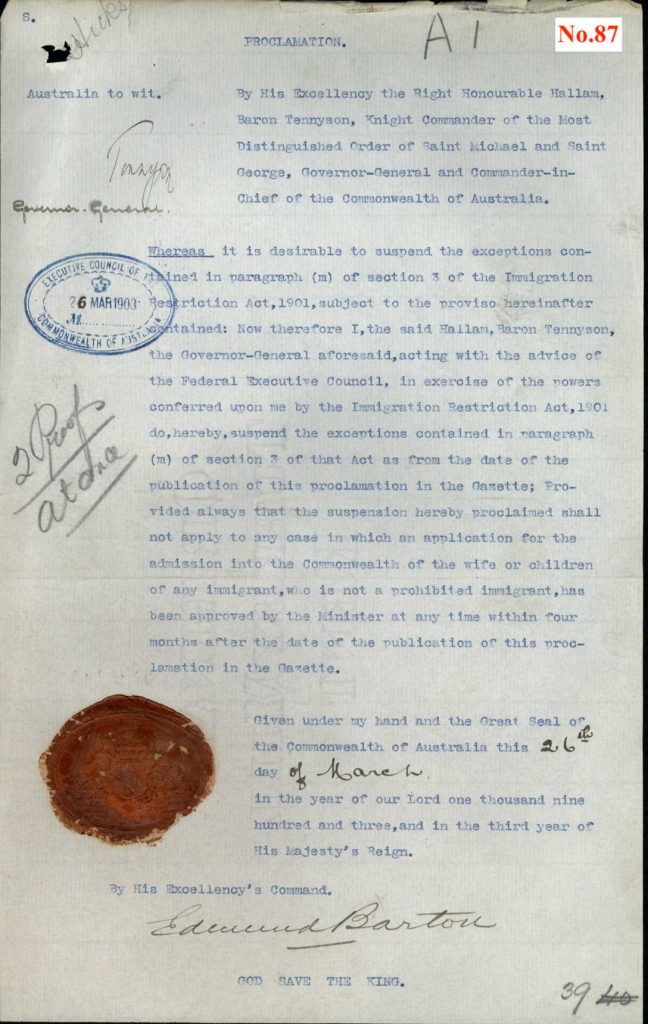In March 1903 the Governor-General of Australia – Hallam Tennyson son of Alfred Tennyson and author of Jack and the Beanstalk (in “English Hexameters”) – by proclamation suspended Section 3, paragraph (m) of the relatively new Immigration Restriction Act. By so doing he, or rather Prime Minister Edmund Barton, was eliminating the possibility for the many Chinese men who had been living in Australia before 1901 to bring their wives or children under 18 years to Australia automatically.

Like all the Immigration Restriction Act there is no mention of Chinese men or their wives as such. Paragraph (m) in full reads that entry to Australia is allowed by:
(m) a wife accompanying her husband if he is not a prohibited immigrant, and all children apparently under the age of eighteen years accompanying their father or mother if the father or mother is not a prohibited immigrant; but so that the exceptions in this paragraph shall not apply if suspended by proclamation; and such suspension may be of general application or limited to any cases or class of cases
This had been a rare concession in legislation designed to make Australia white. (See No.1) Barton at the time declaring the concession was intended to show “that it is not intended to create any undue hardship under the Bill.”[1] When asked why he was now suspending this concession and presumably creating undue hardship, Barton replied: “I have found that this concession has been availed of to a larger extent than I anticipated when the act was framed.” Barton’s concern of course was that this concession would result in “a further addition to our coloured population.” [2]
That Barton had anticipated this “overuse” might be the case is shown by the fact that paragraph (m) is the only one in the Act that allowed for suspension by proclamation. This paragraph is often referred to as specifically concerning the wives of merchants but like its applicability to Chinese people this is only because merchants were the most likely to have been in a position to bring a wife (or second wife) into Australia. Merchants and others of course could and did bring in wives and children but after March 1903 needed to do so under the temporary and discretionary Certificates of Exemption. (See No.77)
In general wives remained in the villages to look after parents and earnings were sent back as regular remittances. (See No.29 and No.61) Or at least this was the ideal and a pattern that most followed for several generations. It is for this reason that women seem to be absent from Chinese Australian history despite the best efforts of many historians to highlight the lives of those who were present in Australia. Of course, women are as present in the history of Chinese Australia as in any other aspect of Australian history. It just needs to be remembered that most were in the villages where they were as a result of Chinese custom and agency. Though certainly Barton and other supporters of the White Australia policy made any changes to this custom as slow and difficult as possible.
Further reading:
Williams, M., 2021. Holding Up Half the Family, Journal of Chinese Overseas 17.1, pp.179-195. https://doi.org/10.1163/17932548-12341438
Kate Bagnall & Julia T. Martínez (Eds) Locating Chinese Women: Historical Mobility between China and Australia, HKU Press, 2021
Robb, Sandi (2019) North Queensland’s Chinese family landscape: 1860-1920. PhD thesis, James Cook University.
Williams, M., 2021 Australia’s Dictation Test: The Test it was a Crime to Fail, Brill.
[1] Edmund Barton, House of Representatives, 7 August 1901.
[2] Examiner, 2 April 1903, p.3.

